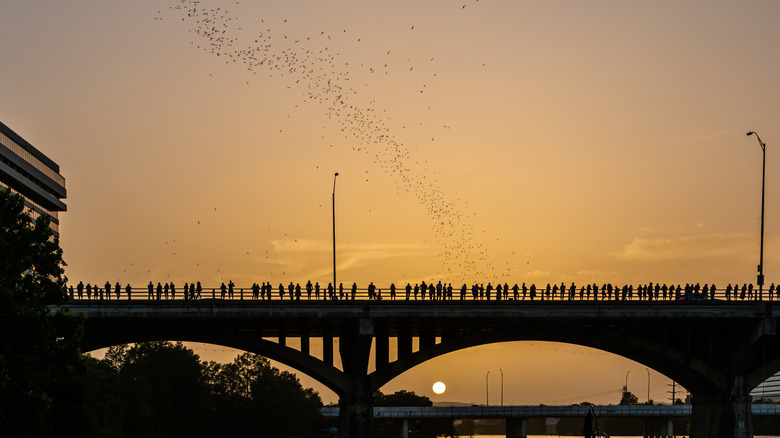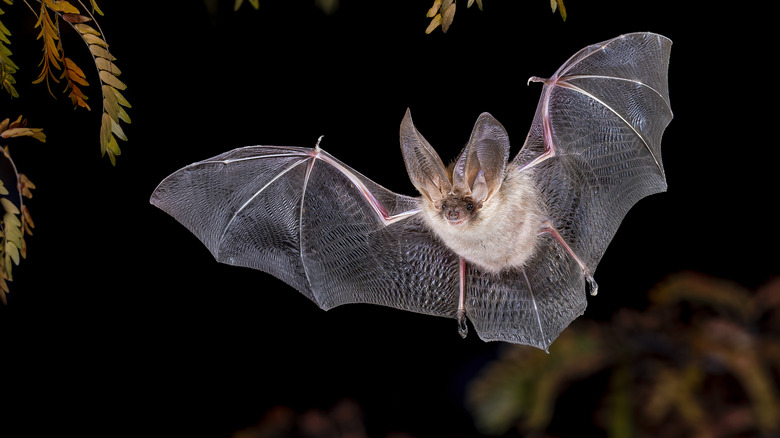Witness America's Largest Urban Bat Colony With Serene Sunset Views At This Unique Texas Bridge
Austin is considered one of Texas' best shopping destinations as well as a great vacation spot for film lovers. The city is also home to quirky and artsy hidden gems, but that's not all the Lone Star State's capital offers. Downtown Austin is home to a top tourist destination, the Ann W. Richards Congress Avenue Bridge. Here, the largest urban bat colony in both the U.S. and the world amazes residents and visitors alike with the nocturnal creatures' daily sunset flights. The best part? You can easily witness this spectacle free of charge.
Every year, more than 1 million bats visit Austin, attracting thousands of tourists. These bat enthusiasts gather on and around Congress Bridge — overlooking the Lady Bird Lake — in hopes of glimpsing this natural phenomenon. According to experts, these animals have finally started to grow on people's hearts not only as incredible pest controllers but as overall living beings. This, of course, translates into some great news for bat conservation in America.
So, if millions of bats flying around just as the sun sets sounds like your cup of tea, then the capital city of Texas is the place for you. Austin can be easily reached by flying into the Austin-Bergstrom International Airport, just 7 miles away from the city's downtown.
How to see the Austin bats up close
Before planning your bat-watching trip to Austin, there are a few things you need to take into consideration. First, know that the Mexican free-tailed bats living under Congress Bridge belong to a migratory species. This means that the bats are only visible from March until October; August seems to be the best time for watching them. There's also a bat-centered festival organized during the summer, so be sure to plan accordingly.
Watching the bats comes free of charge, as you just need to walk to the south of Congress Bridge to enjoy the show. Other viewing spots include the Statesman Bat Observation Center and its adjacent bat-viewing area, both located just near the bridge. It's advisable to bring hats and blankets to cover yourself from mosquitoes and bat droppings. If, however, you don't mind spending some bucks and wish to see the sunset and the bats from under the bridge, both Lone Star Riverboat and Capital Cruises offer some really nice boat tours for a fee.
The Lone Star Riverboat tours start at around $14 per person at the time of writing. The ride lasts for about one hour, and the crew will let you in on all the history surrounding this iconic bridge and its bats. Capital Cruises' tours also cost about $14 per person, or for $40 you can kayak around the water instead.
How to observe bats ethically
Bats are sensitive and delicate creatures, even when they have adapted to urban environments. As such, please be sure to engage in responsible practices when visiting Austin's Congress Bridge — or any other bat location, for that matter.
First and foremost, do not try to touch or handle the bats. If you do, you risk transmitting a disease to the vulnerable animals. You also risk getting a disease yourself, so please refrain from any physical contact. On that note, please avoid littering or leaving trash behind after your visit — keeping the bats' habitat clean is also important for overall wildlife and human health.
If you're a photographer or just wish to snap some photos of the flying bats, be sure to turn off your phone and camera's flash. Remember that bats are sensitive to light. Please also try to keep as quiet as possible to avoid any unnecessary disturbance for the animals. Finally, be sure to check the exact time for the sunset, as the sun in Austin can start going down anywhere from 7:30 p.m. to 9 p.m. depending on the month. Once the sky darkens, be patient, as the bats can sometimes take a while to come out.


